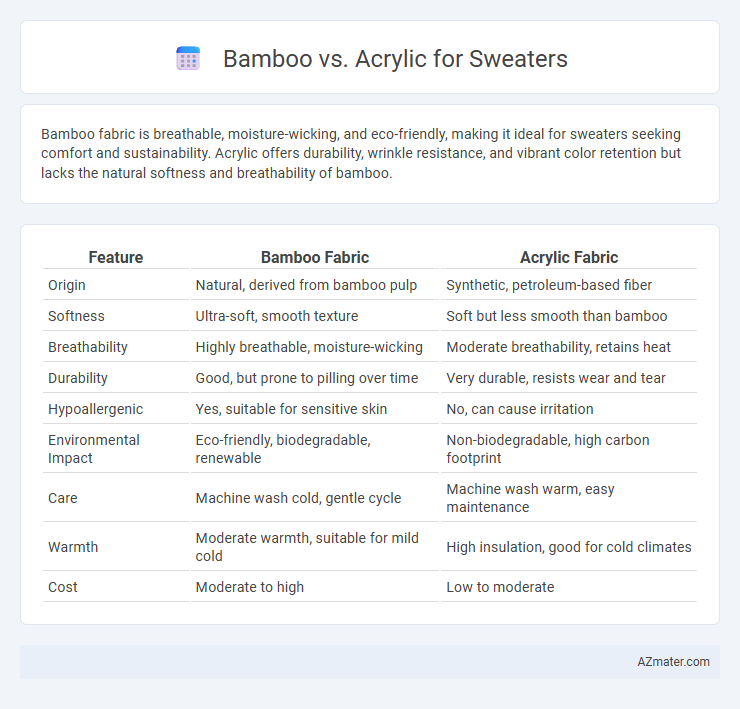Bamboo fabric is breathable, moisture-wicking, and eco-friendly, making it ideal for sweaters seeking comfort and sustainability. Acrylic offers durability, wrinkle resistance, and vibrant color retention but lacks the natural softness and breathability of bamboo.
Table of Comparison
| Feature | Bamboo Fabric | Acrylic Fabric |
|---|---|---|
| Origin | Natural, derived from bamboo pulp | Synthetic, petroleum-based fiber |
| Softness | Ultra-soft, smooth texture | Soft but less smooth than bamboo |
| Breathability | Highly breathable, moisture-wicking | Moderate breathability, retains heat |
| Durability | Good, but prone to pilling over time | Very durable, resists wear and tear |
| Hypoallergenic | Yes, suitable for sensitive skin | No, can cause irritation |
| Environmental Impact | Eco-friendly, biodegradable, renewable | Non-biodegradable, high carbon footprint |
| Care | Machine wash cold, gentle cycle | Machine wash warm, easy maintenance |
| Warmth | Moderate warmth, suitable for mild cold | High insulation, good for cold climates |
| Cost | Moderate to high | Low to moderate |
Introduction to Sweater Knitting Materials
Bamboo and acrylic fibers are two popular materials used in sweater knitting, each offering distinct advantages. Bamboo yarn is known for its softness, breathability, and natural moisture-wicking properties, making it ideal for sensitive skin and warmer climates. Acrylic yarn, on the other hand, provides durability, vibrant color retention, and affordability, often chosen for easy-care and long-lasting garments.
Overview of Bamboo Yarn for Sweaters
Bamboo yarn is a highly sustainable and eco-friendly material known for its softness, breathability, and natural antibacterial properties, making it an ideal choice for sweaters. Its moisture-wicking ability keeps wearers comfortable by regulating temperature and reducing odor, while the fiber's durability ensures long-lasting garments. Bamboo yarn also offers excellent drape and a smooth texture, providing a luxurious feel that enhances sweater quality and wearability.
Key Features of Acrylic Yarn
Acrylic yarn offers excellent durability and resistance to moisture, making it ideal for sweaters that require long-lasting wear and easy care. Its synthetic fibers provide vibrant color retention and resist fading, maintaining a bright appearance over time. Acrylic is also lightweight and hypoallergenic, suitable for individuals sensitive to natural fibers like wool or bamboo.
Softness and Texture Comparison
Bamboo sweaters offer exceptional softness with a silky smooth texture that feels gentle against the skin, making them ideal for sensitive skin types. Acrylic sweaters provide a lightweight, wool-like feel with a slightly coarser texture, which can vary depending on the fabric's quality and knitting technique. Bamboo fibers also naturally wick moisture and resist odors, enhancing overall comfort beyond just softness.
Durability and Longevity
Bamboo fiber offers superior durability with its natural strength and resistance to pilling, making bamboo sweaters long-lasting and resilient to everyday wear. Acrylic, while affordable and lightweight, tends to lose shape and develop pills over time, reducing the longevity of acrylic sweaters significantly. Investing in bamboo sweaters ensures extended lifespan and consistent quality due to their inherent durability properties.
Warmth and Insulation Properties
Bamboo fabric offers superior moisture-wicking and breathability, making it ideal for maintaining warmth without overheating in sweaters. Acrylic fibers provide excellent insulation due to their ability to trap heat, mimicking wool's thermal properties while remaining lightweight. Bamboo's natural temperature regulation contrasts with acrylic's synthetic warmth retention, influencing the choice based on desired comfort and climate conditions.
Ease of Care and Maintenance
Bamboo sweaters are highly breathable and naturally moisture-wicking, making them less prone to odors and easier to keep fresh with minimal washing. Acrylic sweaters offer durability and resistance to shrinking and wrinkles, but they may attract static and require careful washing to avoid piling. Both fibers benefit from gentle machine washing and air drying, though bamboo demands lower temperatures to preserve its softness and longevity.
Environmental Impact: Bamboo vs Acrylic
Bamboo sweaters offer a significant environmental advantage due to bamboo's rapid growth and minimal need for pesticides or fertilizers, making it a highly sustainable fiber. In contrast, acrylic sweaters are produced from petroleum-based synthetic fibers, contributing to fossil fuel depletion and releasing microplastics that persist in ecosystems. The biodegradability of bamboo fibers further reduces environmental waste compared to the non-biodegradable nature of acrylic materials.
Cost and Availability
Bamboo sweaters are generally more expensive due to sustainable production processes and limited sourcing, while acrylic sweaters offer a budget-friendly alternative with widespread availability. Bamboo fibers provide natural antibacterial properties and breathability, but their smaller-scale manufacturing increases cost and limits stock. Acrylic is mass-produced, making it easier to find in a variety of styles and price points across most retail outlets.
Which Material is Best for Your Sweater?
Bamboo fabric offers superior breathability, moisture-wicking properties, and natural antibacterial benefits, making it ideal for sweaters that need to regulate temperature and stay fresh throughout the day. Acrylic, a synthetic fiber, is more durable, resistant to wrinkles and shrinking, and generally more affordable, providing long-lasting shape retention and easy care. Choosing the best material depends on prioritizing comfort and sustainability with bamboo or opting for cost-effectiveness and durability with acrylic.

Infographic: Bamboo vs Acrylic for Sweater
 azmater.com
azmater.com